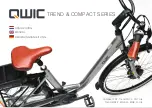
39
e
f
g
h
Rim brakes
Racing/Side-pull brakes
Functioning and wear
Actuating the levers on the handlebars
(e)
and
cables
(f)
causes a brake pad
(g)
to be pressed
against a brake surface. The ensuing friction slows
down the wheel. If water, dirt or oil come into con-
tact with one of the braking surfaces, this changes
the coefficient of friction and deceleration is reduced.
This is why brakes respond with a slight delay and
less powerfully in wet weather.
In order to maintain their effectiveness, brakes need
to be checked and readjusted at regular intervals.
The friction generated by braking causes wear to the
brake pads as well as to the rims. Frequent rides in
the rain and dirt and over hilly terrain can accelerate
wear on both braking surfaces. Some rims are pro-
vided with wear indicators, e.g. grooves or circular in-
dentations. If the rim is worn down to the point where
the grooves or indentations are no longer visible, it
needs to be replaced. Once the abrasion of the rim
has reached a certain critical point, the rim may break
under the tire pressure. This can make the wheel jam
or the inner tube burst. Risk of an accident!
Functional check
Test the brakes at standstill by firmly pulling the brake
levers towards the handlebars. The brake pads of rim
brakes must hit the rim evenly with their entire surface
without touching the tire during braking or in open
condition or in between.
Check whether the brake blocks are perfectly aligned
with the rims and are still sufficiently thick. You can
judge the wear of the brake pads by the appearance
of grooves. If the pads are worn down to the bottom
of the grooves
(h)
, it is time to replace them. Be sure
to observe the according instructions of the respec-
tive manufacturer.
The brake lever must always remain clear of the han-
dlebars. You should not even be able to pull them all
the way to the handlebars in the event of an emer-
gency stop. If this is the case, however, observe the
following chapter “Synchronizing and readjusting”.
See your CENTURION dealer and ask him to exam-
ine the remaining thickness of the rims when you are
through your second set of brake pads at the latest.
He has special measuring devices to determine the
remaining thickness of the rims.
Both brake arms must hit the rim simultaneously,
when you actuate the brake lever. They must keep
off the tire.
Summary of Contents for ROAD BIKE ISO 4210-2
Page 95: ......
















































